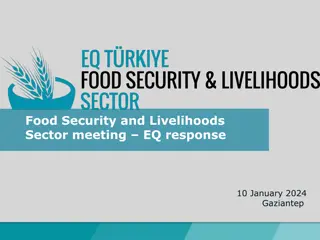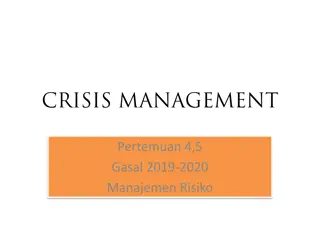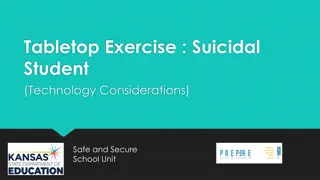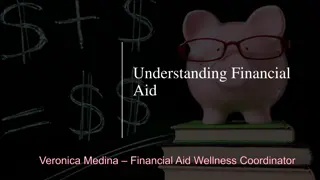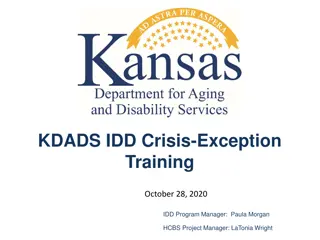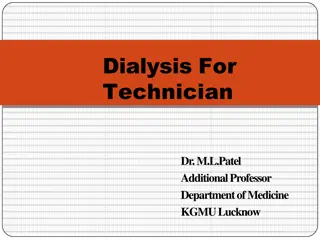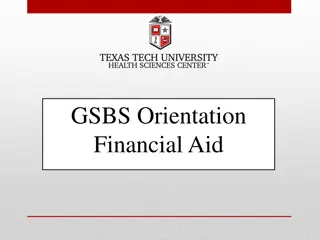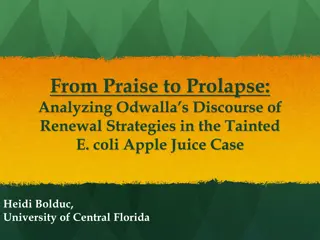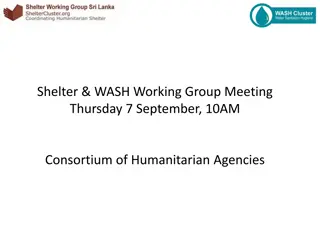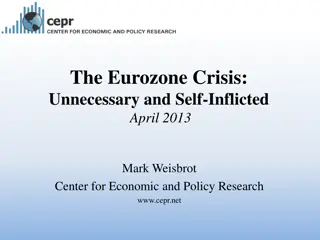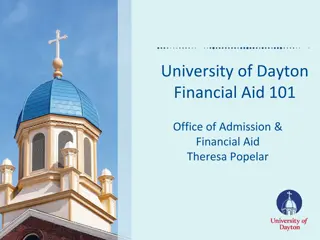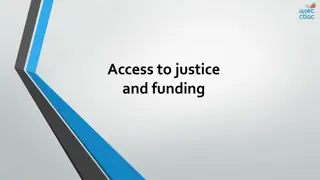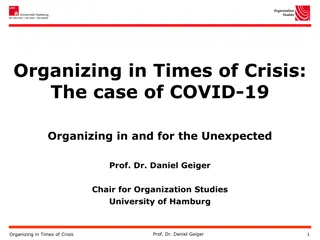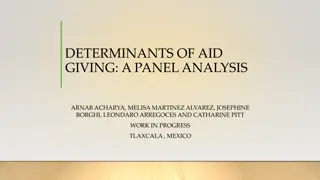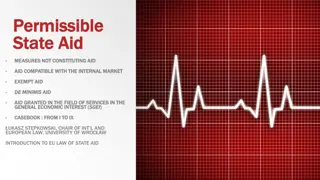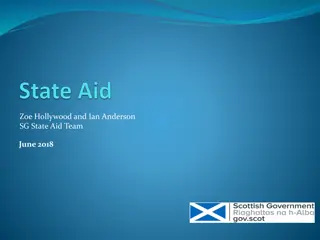Cash Transfer Programming in Crisis Response
Explore the key concepts and terminology related to cash transfer programming (CTP) in humanitarian emergencies. Learn about unconditional and conditional cash grants, how resources are transferred to beneficiaries, and the different modalities used to provide aid in times of crisis.
Download Presentation

Please find below an Image/Link to download the presentation.
The content on the website is provided AS IS for your information and personal use only. It may not be sold, licensed, or shared on other websites without obtaining consent from the author. Download presentation by click this link. If you encounter any issues during the download, it is possible that the publisher has removed the file from their server.
E N D
Presentation Transcript
Setting the scene: Different response modalities to deliver aid in times of crisis
Session outcomes By the end of the session, participants will be able to: Have shared understanding of key CTP concepts and modalities Demonstrate a shared understanding of cash transfer programming (CTP) and in-kind terminology
Concepts and terminology
What is cash transfer programming? Cash transfer programming in emergencies is one form of humanitarian response which can be used to address basic needs and/or protect, establish or re-establish livelihoods. IFRC and ICRC Guidelines for cash transfer programming (CaLP CTP Level I Training)
What is cash transfer programming? Cash interventions transfer resources to people by giving them cash or vouchers (ODI Good Practice Review)
Unconditional cash grant No demands on beneficiaries and assumes that beneficiaries will use cash to obtain targeted need People are given money as a direct grant with no conditions on use, and without conditions on actions that have to be performed to earn the cash (e.g. No work or behavioural requirements). There is no requirement to repay any money, and people are entitled to use the money however they wish. (CalP, adapted from ODI)
Conditional cash grant Based on requirement on beneficiaries The agency puts conditions on how the cash is spent, for instance stipulating that it must be used to pay for the reconstruction of the family home. Alternatively, cash might be given after recipients have met a condition, such as enrolling children in school or having them vaccinated. (ODI, GPR)
Conditional cash grant A cash transfer conditional upon the beneficiary (a) providing a service of some kind (e.g work) or (b) using a service, (e.g. Attending a school or health clinic; or (c) spending the transfer on an agreed commodity or type of commodity. Conditions are qualifying conditions or use conditions.
Cash for work Payment (in cash or vouchers) is provided as a wage for work, usually in public or community programmes. These may or may not result in the creation of individual, public or community assets. Cash grant with the condition of work. Cash for assets (e.g. Irrigation systems): sub-set of CFW.
Vouchers Paper or electronic entitlements which can be exchanged with specified retailers / retail outlets or service centres for a range of good or services. (Calp) A voucher is a paper, token or electronic card that can be exchanged for a set quantity or value of goods, denominated either as a cash value (e.g. $15) or as predetermined commodities or services (e.g. 5kg of maize; milling of 5kg of maize). Vouchers are redeemable with preselected vendors or at voucher fairs set up by the implementing agency. (ODI)
Voucher transfer modalities Commodity vouchers Exchangeable for a fixed quantity of goods and / or services Cash vouchers Exchangeable for the equivalent cash value with a choice of specified items Vouchers include a restriction: by specifying items or services and linking them to service providers or retailers. Conditionality can also apply to vouchers.
What is in kind programming? Distribution made in the form of stock rather than cash
In kind modalities Food items Internationally procured, nationally or regionally procured. Food for work / food for training / food for . General food distribution Targeted food distribution Cereal banks Non-food items (hygiene and sanitation, shelter )
Cash transfer modalities In workshop: Not in workshop: Unconditional grants Social assistance Conditional grants Microfinance Loans Savings Insurance Cash for work Cash vouchers Commodity vouchers
Session outcomes By the end of the session, participants will be able to: Be clear about the perceived benefits of CTP. Understand that all modalities can be used in most contexts across programme cycle Understand use, preconditions, advantages and disadvantages of each response modality Understand importance of needs and market assessment in determining most appropriate response modality selected
Activity: Comparative analysis 1. When would you use each type of transfer? 2. Which preconditions are necessary for each? 3. What are their advantages and disadvantages? Cash for work Uncondi- tional grants Vouchers In-kind When to use Pre- conditions Advantages Dis- advantages
Why cash transfers? Empowerment and dignity (transfer of power) Flexibility and choice (time, content...) Reduced cost to beneficiaries (transport, etc..) Do no harm to markets & Multiplier effects Supports or revitalises local trade & economy Supports longer economic recovery Links relief with recovery Cost efficient for agencies and participants
Why in kind distributions? People s preference Ensure that people get what they need (in quality and quantity) Not available in country or region (in quality or quantity) Cost efficient for agencies and participants Cash not available or of very instable value More secure Stabilise prices (by making available)
CTP preconditions Functioning markets Availability of products: supply and re-supply of goods Sellers with resources Trader willingness and capacity Cash based economy Purchasing power Social access to markets Physical access to markets Political acceptance Community agreement Reasonable and fairly stable prices Reliable payment system
In kind preconditions Non functioning markets or highly disrupted markets Non availability of products Non physical access to markets Non social access to markets Political acceptance Community agreement Distribution and transport capacity Reliable distribution system
CTP sector experience WASH Shelter Health, nutrition Livelihoods Livestock Education Protection Examples of integrated CTP? Is it different than in-kind?
Activity: the Cash Game We are now going to play a game of Precondition agree or disagree in groups. This is from the 48 hour tool. Each group will be given some cards on each card there is a statement about EFSL programmes and preconditions The group members take it in turns to pick up a card and reads it out to the other members The group then decide if they agree or disagree with what the card says Then the next person takes the next card and so on
To cash or not to cash To identify contextually appropriate responses to meet needs, we must consider: When to cash or not to cash ? Or a combination of cash and in-kind modalities? Sectoral objectives and operational roles Real costs of cash versus in-kind responses Possible delivery methods for each modality Advantages and disadvantages of each modality Support needs and roles in each modality
Remember Like any other commodity, providing cash or vouchers is not a programme in itself Cash/vouchers are a modality for addressing needs and achieving objectives.
Session outcomes By the end of the session, participants will be able to: Recap the different possible delivery agents, mechanisms and instruments in CTP programming Understand that the best way to deliver CTP is context specific Understand that the use of vouchers does not equate to CTP. Understand that vouchers can be commodity or cash vouchers Understand that vouchers can be transfer of purchasing power (cash) or act as the delivery instruments in an in kind response.
Cash delivery structure The delivery agent: who delivers the cash Governments, aid agencies, banks, post offices, mobile phone companies, micro- finance companies, security companies, local traders and remittance officers. The delivery mechanisms: how the cash is delivered direct delivery (cash in envelopes), Financial service providers (banks, post offices, micro-finance institutions, remittance companies...) Retailers / traders mobile phones. Delivery instrument: by what means by which the beneficiary accesses the money Direct delivery, mobiles, cheque, electronic transfer, point of sale, paper token / voucher, mobile banking, debit/smart cards, ATMs, remittances There is no best way to deliver cash transfers. Whether it makes sense to give people money in envelopes, open bank accounts for them or use mobile banking approaches depends on a context-specific analysis of the options available in each crisis.
Vouchers a closer look There has been a variety of ways that vouchers have been used in responses. Just using a voucher in programme design does not necessarilymean that you are actually implementing a CTP. A voucher can be a modality and an instrument.
Example one An agency decides to distribute vouchers for a specific ration. But this ration, and all means of delivery of this ration are still managed and owned by the agency. What kind of response is this?
Example two An agency delivers rations that are accessed when exchanged for a voucher. An agency distributes unconditional cash vouchers (equivalent of 15) to beneficiaries as a token for cash, or exchange for cash at a bank. What kind of response is this?
Example three An agency distributes a commodity voucher for specific items. This voucher is not inflationary nor attached to price....so it could be thought of as in kind. However, it is not the agency who owns the whole process. Traders are being used and cash is getting into the market system. What kind of response is this?
Example four An agency distributes a voucher for an equivalent cash value, with certain specified conditions. These conditions may be either on the choice of shop, or the range of items. What kind of response is this?
The spectrum Vouchers as delivery mechanism, but in kind response Conditional commodity voucher Conditional cash voucher Unconditional cash voucher In kind CTP Voucher as instrument Agency owned High level of conditionality Voucher as modality Beneficiary choice Lower level or no conditionality
Main CTP recap messages 2 direct transfer modalities: cash and in-kind CTP is increasingly common across a range of contexts and sectors. Cash, in-kind, or combined responses will be based on assessment and analysis. Modalities and delivery options are guided by context and objectives. Finance, logistics, HR, and programme collaboration reduces response time and increases effectiveness. Vouchers do not necessarily mean a CTP







